Rare Artifacts Found on 3,300-year-old Shipwreck
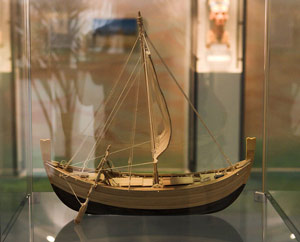
The 3,300 year old ship sank in 150 feet of water. Credit: INA
How would you like to dive on a 3,300-year-old shipwreck sunk in 150 feet of water in the Mediterranean Sea off Uluburun, (pronounced u loo bu run) near Kas, Turkey? It’s possible if you hook up with the Institute of Nautical Archaeology (INA) Texas A & M University, College Station, Texas, whose students and professors have visited it for years. Discovered by a sponge diver in 1982 off the coast of Uluburun, the wreck is named for its location and was visited extensively from 1984 to 1994. It’s believed the vessel might have sunk from strong gusts of wind that swept from shore and overturned it. A shift in the heavy cargo could have also contributed to its demise. This is speculation since there’s no evidence of the hull striking large rocks near the shoreline. This Bronze Age site is known as “one of history’s greatest shipwrecks” and although it has given up most of its artifacts to museums, it’s still explored by divers who are associated with archaeology groups or obtain a permit from government officials.
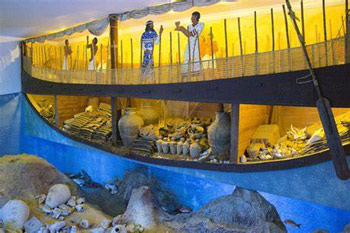
The Uluburun was a small ship with a large cargo. Credit: INA
Samples salvaged from the merchant ship helped identify it. First examined were the tree rings of a branch supporting a storage shelf in the wreck. Next, remains from the keel revealed construction clues along with dunnage (padding used to secure cargo) and shreds from the crew’s personal belongings. It’s amazing what was preserved, some of it pressed between planks that remained from the keel. The cargo consisted of many raw materials used in building and trading. Ten tons of copper ingots was a big discovery along with one ton of tin. Advanced technology of the times smelted the tin separately, then added it to the hot copper to make a bronze alloy. In turn, this contributed to the Bronze Age which was used for classifying and studying ancient societies in northern Europe. It lasted from 3300 BC to 1200 BC, characterized by writing found on bronze tablets and other features of urban civilization. The Bronze, Stone and Iron Ages were the successive stages for man’s technological development in Europe. It’s believed that the “real rise in civilization” came with the introduction and development of bronze.
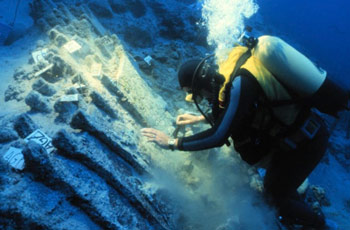
Diver examines some of the 10 tons of copper and one ton of tin. Credit: INA
Further finds include faience (glazed pottery drinking vessels), gold and silver jewelry, coins, ivory, pottery, lamps, weapons, tools, figs, olives, grapes and whole pomegranates. Much more was discovered as the number of dives and discoveries increased from hundreds to thousands over the 10-year span. Origins of the cargo range from Northern Europe to Africa and as far west as Sicily and Sardinia and east to Mesopotamia. A circular trade route went from Syria, Palestine and Cyprus to ports on the Aegean Sea. It returned home via North Africa and Egypt, providing a vast trade network throughout the Eastern Mediterranean. Cargoes appeared to be products from nine or ten cultures. This indicates that the late Bronze Age conducted international trade following the desire of the wealthy for lavish things and continued construction by developers in the Near East. Scholars of the Uluburun wreck depict a thriving cultural network of the late Bronze Age in the Mediterranean. For now, it’s an accepted conclusion that the ship sank at the end of the 14th century BC.
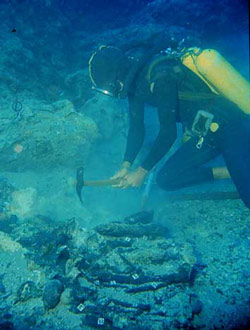
A diver digs carefully for ancient artifacts. Credit: INA
The remains of the wreck and its scattered cargo indicate it was approximately 50 feet long with mortise and tendon joints like those of Greco-Roman ships in later centuries. The cedar and oak in the planks and keel came from the mountains of Lebanon, southern Turkey and central Cyprus. The ship carried two dozen stone anchors which were the same as the ones used to build temples in Syria, Palestine and Cyprus. Brush and sticks were used as dunnage to protect the planks from the heavy cargo that acted as ballast.
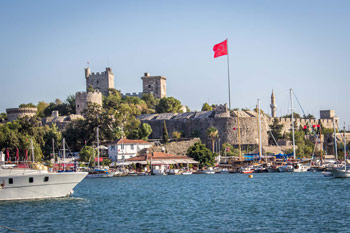
Bodun Castle is the site of an outstanding shipwreck museum. Credit: Bodun Tourist Bureau
Hundreds of ships and their cargos have been excavated from the Mediterranean but the Uluburun’s shipment, on display in the Museum of Underwater Archaeology at Bodrum, remains one of the most spectacular. A hall, built especially for the wreck, has been added to the Crusaders’ Castle once occupied by the Order of the Knights Hospitaller. Kindred to the Knights Templar, the Hospitallers became one of the most formidable military orders in the Holy Land. A perfect place for the Uluburun artifacts, the museum reserves a full section for what was believed to be a Syrian merchant’s vessel. Of the 14 halls in the museum, nine are devoted to shipwrecks. The Uluburun Hall displays everything including ingots, gold and silver jewelry, tools, weapons, pots, glassware, lamps, ivory, ceramic amphoras, edibles and more.

Map shows location of the Uluburun. Credit: Bodun Tourist Bureau
NOTE: The popular town of Bodrum is located near the southern Aegean coast of Turkey. It’s a busy tourist attraction and unfortunately some tourists vacation in Bodrum and never visit the museum. Hailed by the late shipwreck researcher Bob Fleming as one of the “world’s most distinguished museums,” it was completed in 1999 and has been visited by millions of people since then. It’s amazing to see what was salvaged considering it’s all over 3,000 years old.
Author: Ellsworth Boyd
Ellsworth Boyd, Professor Emeritus, College of Education, Towson University, Towson, Maryland, pursues an avocation of diving and writing. He has published articles and photo’s in every major dive magazine in the US., Canada, and half a dozen foreign countries. An authority on shipwrecks, Ellsworth has received thousands of letters and e-mails from divers throughout the world who responded to his Wreck Facts column in Sport Diver Magazine. When he’s not writing, or diving, Ellsworth appears as a featured speaker at maritime symposiums in Los Angeles, Houston, Chicago, Ft. Lauderdale, New York and Philadelphia. “Romance & Mystery: Sunken Treasures of the Lost Galleons,” is one of his most popular talks. A pioneer in the sport, Ellsworth was inducted into the International Legends of Diving in 2013.
5 Comments
Submit a Comment
All Rights Reserved © | National Underwater and Marine Agency
All Rights Reserved © | National Underwater and Marine Agency
Web Design by Floyd Dog Design
Web Design by Floyd Dog Design

A very enjoyable article
Thank you! It was quite enjoyable to write. I’m still amazed at what the salvors retrieved from this ancient Bronze Age shipwreck. It gave many clues as to what life was like long ago.
Thanks for another great article documenting life and technology from the past. The evidence gained from archaeological exploration certainly fleshes out the creative developments of early cultures. Again, thanks for bringing the past to life again.
Thanks for your kind words. It was interesting to research this ship. The salvors did make some interesting finds that helped them identify the culture of the times. What amazes me is the amount of cargo that was aboard that small vessel.
Thank you so much for such great reading. I would love to crew with the team on a adventure.